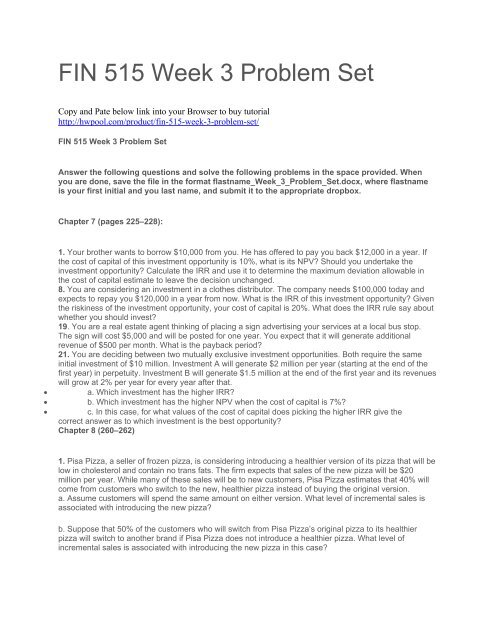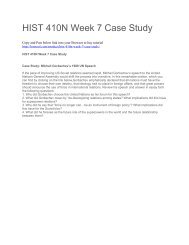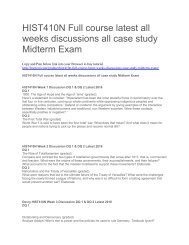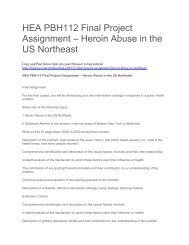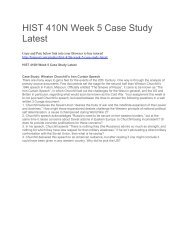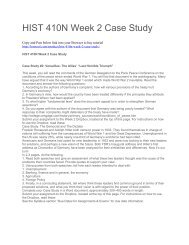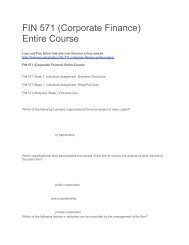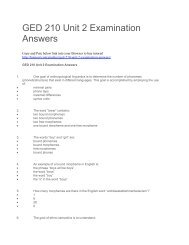FIN 515 Week 3 Problem Set
Create successful ePaper yourself
Turn your PDF publications into a flip-book with our unique Google optimized e-Paper software.
<strong>FIN</strong> <strong>515</strong> <strong>Week</strong> 3 <strong>Problem</strong> <strong>Set</strong><br />
Copy and Pate below link into your Browser to buy tutorial<br />
http://hwpool.com/product/fin-<strong>515</strong>-week-3-problem-set/<br />
<strong>FIN</strong> <strong>515</strong> <strong>Week</strong> 3 <strong>Problem</strong> <strong>Set</strong><br />
Answer the following questions and solve the following problems in the space provided. When<br />
you are done, save the file in the format flastname_<strong>Week</strong>_3_<strong>Problem</strong>_<strong>Set</strong>.docx, where flastname<br />
is your first initial and you last name, and submit it to the appropriate dropbox.<br />
Chapter 7 (pages 225–228):<br />
1. Your brother wants to borrow $10,000 from you. He has offered to pay you back $12,000 in a year. If<br />
the cost of capital of this investment opportunity is 10%, what is its NPV? Should you undertake the<br />
investment opportunity? Calculate the IRR and use it to determine the maximum deviation allowable in<br />
the cost of capital estimate to leave the decision unchanged.<br />
8. You are considering an investment in a clothes distributor. The company needs $100,000 today and<br />
expects to repay you $120,000 in a year from now. What is the IRR of this investment opportunity? Given<br />
the riskiness of the investment opportunity, your cost of capital is 20%. What does the IRR rule say about<br />
whether you should invest?<br />
19. You are a real estate agent thinking of placing a sign advertising your services at a local bus stop.<br />
The sign will cost $5,000 and will be posted for one year. You expect that it will generate additional<br />
revenue of $500 per month. What is the payback period?<br />
21. You are deciding between two mutually exclusive investment opportunities. Both require the same<br />
initial investment of $10 million. Investment A will generate $2 million per year (starting at the end of the<br />
first year) in perpetuity. Investment B will generate $1.5 million at the end of the first year and its revenues<br />
will grow at 2% per year for every year after that.<br />
a. Which investment has the higher IRR?<br />
b. Which investment has the higher NPV when the cost of capital is 7%?<br />
c. In this case, for what values of the cost of capital does picking the higher IRR give the<br />
correct answer as to which investment is the best opportunity?<br />
Chapter 8 (260–262)<br />
1. Pisa Pizza, a seller of frozen pizza, is considering introducing a healthier version of its pizza that will be<br />
low in cholesterol and contain no trans fats. The firm expects that sales of the new pizza will be $20<br />
million per year. While many of these sales will be to new customers, Pisa Pizza estimates that 40% will<br />
come from customers who switch to the new, healthier pizza instead of buying the original version.<br />
a. Assume customers will spend the same amount on either version. What level of incremental sales is<br />
associated with introducing the new pizza?<br />
b. Suppose that 50% of the customers who will switch from Pisa Pizza’s original pizza to its healthier<br />
pizza will switch to another brand if Pisa Pizza does not introduce a healthier pizza. What level of<br />
incremental sales is associated with introducing the new pizza in this case?
6. Cellular Access, Inc. is a cellular telephone service provider that reported net income of $250 million for<br />
the most recent fiscal year. The firm had depreciation expenses of $100 million, capital expenditures of<br />
$200 million, and no interest expenses. Working capital increased by $10 million. Calculate the free cash<br />
flow for Cellular Access for the most recent fiscal year.<br />
12. A bicycle manufacturer currently produces 300,000 units a year and expects output levels to remain<br />
steady in the future. It buys chains from an outside supplier at a price of $2 a chain. The plant manager<br />
believes that it would be cheaper to make these chains rather than buy them. Direct in-house production<br />
costs are estimated to be only $1.50 per chain. The necessary machinery would cost $250,000 and would<br />
be obsolete after 10 years. This investment could be depreciated to zero for tax purposes using a 10-year<br />
straight-line depreciation schedule. The plant manager estimates that the operation would require<br />
$50,000 of inventory and other working capital upfront (year 0), but argues that this sum can be ignored<br />
because it is recoverable at the end of the 10 years. Expected proceeds from scrapping the machinery<br />
after 10 years are $20,000.<br />
If the company pays tax at a rate of 35% and the opportunity cost of capital is 15%, what is the net<br />
present value of the decision to produce the chains in-house instead of purchasing them from the<br />
supplier?


